Northeast Vietnam boasts nature as you've never seen it, and as you only can atop a bright yellow motorbike. Black rock forests, rice terraces climbing to the clouds, and unscalable mountains would be enough to make the area around Ha Giang a must-visit destination, but when you add in the ubiquitous presence of the Black Hmong, our two day motorbike adventure becomes a can't miss.
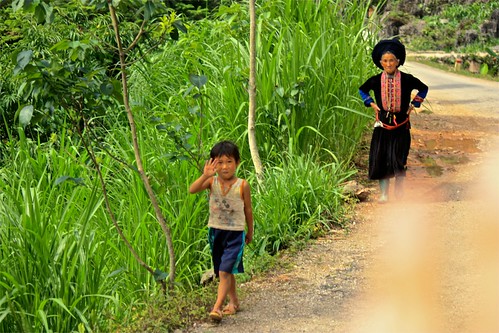
See and Do
Mention Ha Giang in conversation and you'll get one of two responses: a confused brain-searching look, or a reverence that passes across the listener's face. The towns in Vietnam's far northeast aren't on many itineraries, but for those in the know, they're top destinations that boast the best of the North's mind-boggling landscape. Even the NY Times got in on the craze a few years ago, writing what can only be described as an adjective-filled ode to the area.
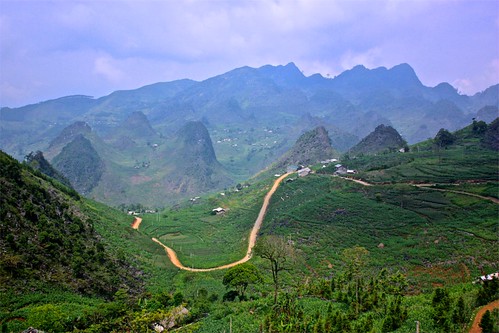
I'm not sure how we decided to travel here, but decide we did, even though we had only three days before our flight out of the country and nothing at all prearranged. We didn't expect it to be difficult to hire a motorbike and take off into the wild, but we were wrong. This is a different Vietnam, one where hotel workers speak no English; where live pigs and chickens are transported atop motorbikes; where you get dog meat when you order vegetables and noodles; and where being foreign (and especially white) means everyone in town comes to watch you talk, walk, and eat.
This is a place where you need a permit to spend the night, one where electric pink scarves and high-pitched screams of "hello" from the cliffs above the road are the only things that alert you to the presence of people. It's a place where children carry double their weight of sticks in bamboo baskets upon their backs, where men dress in high-necked black tunics and matching berets, and where the "forests" are black stone.
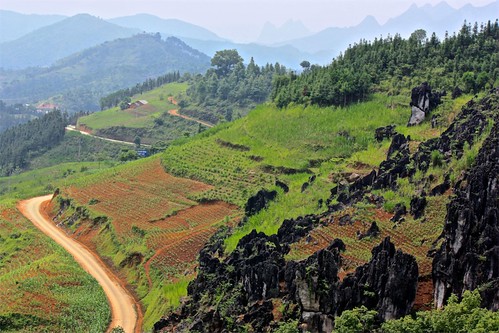
It's really a land like no other, and it can only be properly explored on a motorbike and with sufficient time. The first thing we learned, and quickly, was that with no prearrangements, we would lose a day in Ha Giang. This would be bad enough if we had ample time, given that Ha Giang isn't the greatest city, but it was worse given that we only had three days to begin with. Now we were down to two.
TIP: Your average speed will be 25km/hour
Budget time accordingly to make sure you're in town before nightfall.
The shortest trip with the most "bang for the buck" takes you to the town of Dong Van, then on to Meo Vac, and then back to Ha Giang. It's 330km and lets you drive the most famous portion of the road, but doesn't allow much time for interacting with the locals, trekking, or letting your butt rest from the motorbike.
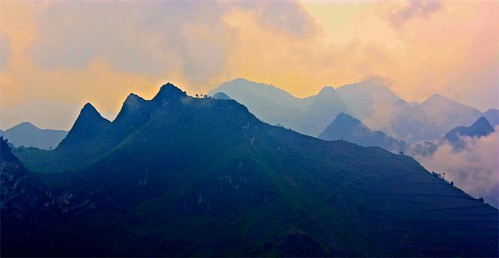
TIP: Allow three days
Not only can you rest from the bike, but you'll be able to trek independently around Dong Van and experience the incredible rice paddies and karst mountains close up.
Unfortunately for us, our already short adventure was cut even shorter two hours in on the first day, when we were hit by a monsoon-like sheet of rain. Luckily, we were in a town, and spent the storm sitting in a local's house, drinking tea, eating sunflower seeds, and watching The Watch, perhaps one of the worst movies ever.
TIP: Prepare for crazy weather
We experienced a two-hour rain delay on our first day that almost forced us to turn around. Make sure you have warm clothes and ponchos in your day pack so you can keep moving until you find shelter.
Because of the rain, we had to rush to get to Dong Van before the sun set, which means we couldn't stop in any of the towns we passed or talk to the locals along the way. Still, the scenery was spectacular, especially after the clouds lifted.
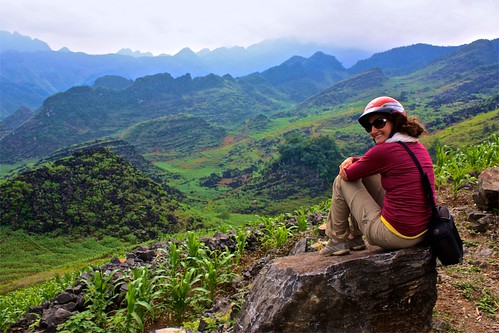
TIP: Use your horn
The roads are in good condition but they're windy with little visibility of what's up ahead. It's better to go crazy on the horn than get hit by a speeding truck or bus.
Technically, all foreigners need to register in either Ha Giang or Dong Van and receive a permit that allows them to stay in the area overnight. It's a leftover rule from when the border with China was less secure and the local Hmong more discontent. Nowadays, I'm fairly certain the only reason the rule stays is because it makes the local officials extra cash.
The easiest way to get the permit is to have your hotel do it for you. Since the hotel we'd intended to stay at was booked (it really wasn't our day), we picked a homestay across the street, handed over our passports, and set out to find some food and beer. To our surprise, the next day when we paid the woman, there was no permit in our passport and no fee for getting one. Maybe we got lucky, or maybe homestays don't report their guests to the government, but it saved us $20-30, which is how much two permits cost.
TIP: Staying one night? Sleep at a homestay and see if you can avoid buying the overpriced "permit," a.k.a
bribe. If you stay longer, it's a bit of a risk to hang out in town without it, but supposedly the police never ask for it anyway. If they do, you could always play the dumb foreigner.
We set off early the next morning, with about 180km to cover. As in the day before, the scenery around us was stunning and the weather was even better, which means we had great views the whole way through. The most famous section of this area is the 20km between Dong Van and Meo Vac. You can see why.
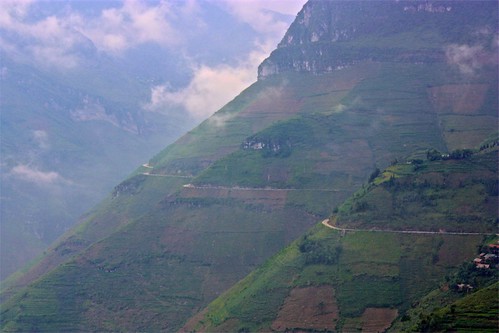
On our way back to Ha Giang, we stopped in several towns and talked with many locals, both at tea shops and on the road. Everyone here is friendly and with so few tourists, curious about who you are.
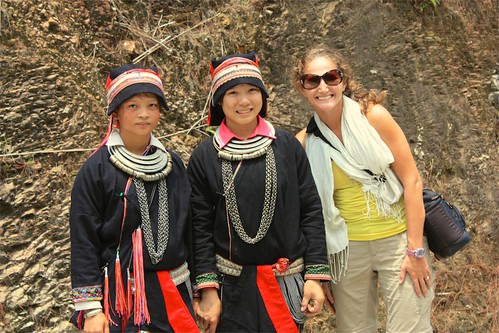
Even with the stops, we made it to Ha Giang by 5pm, with plenty of daylight left.
TIP: Don't backtrack
Instead of returning via Dong Van, make a right at Meo Vac and follow signs to Yen Minh. The road is a bit easier and it'll take you by different scenery.
Sleep
Expect to pay about 200-250,000D to sleep in any of the hotels along the route. There isn't much choice, and the recommended place in Dong Van—Hoang Ngoc—was booked when we arrived.
We opted for one of the many homestays (nghi) in town. For 200,000D, we had a room overlooking the rice paddies and a shared bathroom. Since we were the only guests, it wasn't much of a bother.
Eat and Drink
This is a place that serves you dog when you order vegetarian food. I wish I was kidding...
In all seriousness, eating here won't be the highlight of your trip, so expect meals to be predominantly noodle soup or rice, served in a shack and eaten on a plastic stool.
Our favorite place in Ha Giang served a huge and delicious portion of com chay (vegetables/tofu with rice) for 20,000D. It was on the street parallel to the main road, across the river. The sign outside says com" and pho*.
Yen Minh was where I got dog instead of vegetables, so beware of what you eat.
Dong Van had a few restaurants, but most seem to close around 6pm. We ate at the fried rice place across from our homestay. The meal, at 40,000D, was pretty good and extremely filling. For breakfast, you can try bahn cuon, a rice crepe stuffed with beef.
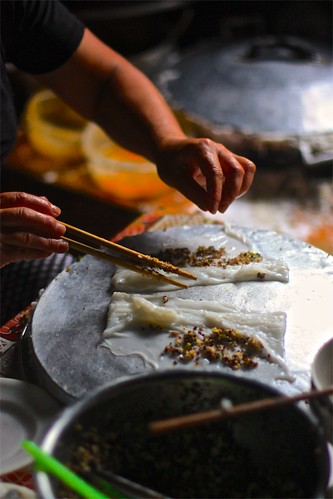
Transport
Getting to Ha Giang from Sapa was difficult, as the local buses leave Lao Cai, which is 1 hour away from Sapa, at 6-6:30 each morning. There's no way to do the trip using public transport in one day, so after a minibus from Sapa (50,000D), you have to spend the night in Lao Cai, something we wouldn't recommend. If you're intent on saving time, your only other option is a private car ($23) at 5am the same morning as you plan to get the bus.
TIP: Do Ha Giang first, Sapa second
The transfers work out a lot better that way, and it saves you a few nights lodging in really boring towns.
Once in Lao Cai, don't pay more than 100,000D for the bus to Ha Giang. The bus driver will rip you off so get your ticket inside the terminal. And say "no" when they ask you to pay extra for luggage. The trip takes about five hours and passes some beautiful scenery.
Ha Giang isn't much better than Lao Cai, so most people try to get out as soon as they get in. By far, the best way to tour the North is by motorbike. Johnny at Rocky Plateau on the main road can hook you up, and even though his rates aren't cheap ($12-15/day), his bikes are in great shape and he speaks enough English to help you with the route.
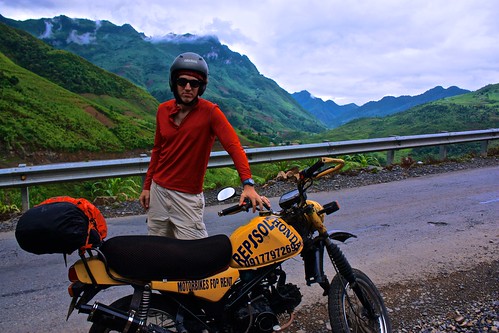
If you don't know how to ride a bike, you can take a bus to Dong Van and then another one to Meo Vac. Frankly, though, the whole point of this trip is to soak in the scenery, something you can't really do through a bus window.
TIP: Can't drive a motorbike? Hire Johnny to take you around for three days
The rates are pretty reasonable (~$50/day) and it's completely worth it.
Getting back to Hanoi is remarkably easy as there's a daily night bus around 8:30pm. It's 200,000D and gets you to the city around 5:30am. If you want to leave the same day you get back from your trip, ask Johnny to book you the ticket.
TIP: Feeling gross after all the biking? Before getting on the night bus, shower at the hotel next to Johnny's office for 70,000D (up to two people)
It's technically a one-hour room, so you decide what to do with the remaining 45 minutes :o)
More Ha Giang and Beyond
Interested in seeing the mountains of Northern Vietnam without paying for a plane ticket? Check out our motorbike photo tour around Northern Vietnam.
Share your backpacking tips for Ha Giang in the comments!
Comments